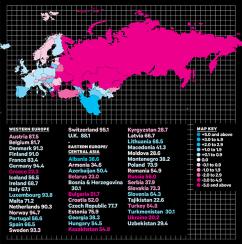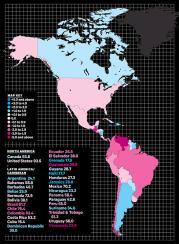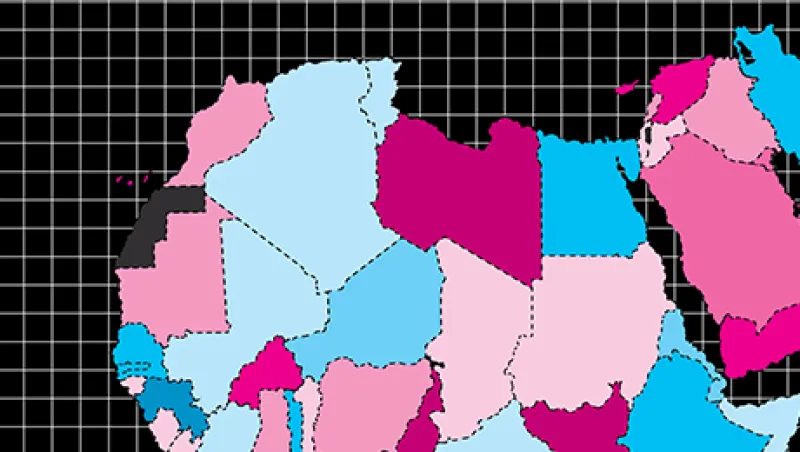The stock market is not the real economy. That mantra seems to have been taken to heart by many of those involved in evaluating credit risk around the world.
A sharp drop in Chinese equities in the past two months has triggered a bout of global financial volatility, pushing stocks into correction territory in most major markets and arousing concern about the health of the worldwide economy. Yet global creditworthiness remains remarkably steady, according to the latest Institutional Investor Country Credit survey. The average rating on the 179 countries in the survey is unchanged from six months ago, at 44.1 on a scale of zero to 100. Ratings of the major industrialized countries show little movement, even in the euro zone. There are numerous declines among countries in Latin America, Africa, the Middle East and Eastern Europe, but these are largely offset by increases in a number of Asian ratings.
Such zigs and zags are typical in the semiannual survey. What’s unusual this time is the diminutive scale of the movements. Most of the ups and downs are no more than a point or two, more like a technical correction than a change of heart. The only significant exception, not surprisingly, is Greece, which went to the brink of default in its standoff with its euro zone partners in June and July. The country’s rating falls another 10.5 points; Greece now ranks 145th in the survey, sandwiched between Myanmar and Togo.
“Things move in cycles in geopolitics and in the economy,” says Admiral James Stavridis, “and as we come out of a period of real political turbulence, particularly in the Arab world, it’s looking like the economic drivers are going to be coming into play.” But Stavridis, the dean of the Fletcher School of Law and Diplomacy at Tufts University in suburban Boston, and Supreme Allied Commander Europe of NATO from 2009 to 2013, says it’s not yet clear where those drivers are propelling the global economy.
“People are taking a wait-and-see attitude,” says Fabian Briegel, an economist at Rabobank in the Netherlands. Creditworthiness is treading water because the good news is never quite good enough, while the bad news is never quite disastrous. A sense of waiting for the other shoe to drop permeates five critical issues.

The biggest question mark is China. Its rating is down only 1.1 points, and the country actually rises one place, to 25th, but observers are increasingly concerned: Do the stock market crisis and recent currency depreciation presage a real crash, a bursting of bubbles that will reverberate through the world? Or is all this just noise typical of a country transitioning from a hyper-fast growth rate to a lower trajectory? Although annual growth of 6 or 7 percent may mean China is off steroids, it would still be one of the highest rates of any major country.
Western Europe, meanwhile, seems to be sorting itself out, says Stavridis. In Greece the Syriza government of prime minister Alexis Tsipras came in with a bang, demanding debt relief from its European partners, but ended with a whimper, negotiating yet another bailout last month. Not only does Greece plummet in this survey, some 68.9 percent of respondents predict its rating will decline further over the next year, and 98.6 percent say it will default within two years. Despite Greece’s ongoing struggles, however, ratings for the rest of Europe have stopped falling. Stavridis attributes this to growing confidence that “the Europeans, as usual, will muddle through.”

The U.S. remains on its steady, unspectacular growth path thanks to a sizable upward revision of second-quarter gross domestic product. The big question continues to revolve around the Federal Reserve Board. The turmoil in China and the sharp drop on Wall Street led many analysts, and some Fed insiders, to suggest that another postponement of the first rate hike might be in order, but the message coming out of the Kansas City Fed’s annual Jackson Hole symposium at the end of August indicated that a tightening is still in the cards for this year. Survey respondents seem confident that the Fed won’t blink this time: 74.7 percent say it will raise rates in the second half; 24.0 percent think it will move in the first half of 2016.
It’s no wonder ratings are becalmed for most of the advanced countries. That’s certainly the case for the industrialized countries, says Afshin Molavi, a fellow at Johns Hopkins University’s Paul H. Nitze School of Advanced International Studies and a senior adviser at Oxford Analytica. “The U.S. is showing signs of modest growth; Europe is showing signs of modest growth. It’s by no means impressive. It’s kind of plain vanilla, but people are saying, ‘I’ll take it for now,’” Molavi notes.
Elsewhere, Vladimir Putin’s saber-rattling is driving down ratings not only in Russia (–3.8 points) and Ukraine (–3.6) but throughout Eastern Europe. “Putin is frozen in place because oil prices are so low, so I don’t think you’re going to see any more serious adventurism out of him,” says Stavridis.
And then there’s energy. Fracking and growing U.S. energy independence have already transformed the global energy market and depressed prices; the diplomatic agreement to contain Iran’s nuclear program threatens to knock prices even lower by unleashing fresh Iranian supply. “The oil market is waiting to see if the Iranian deal will go through and put an end to sanctions on Iran,” says one New York–based bank risk analyst. “If it does, oil prices will stay below $70 for the foreseeable future.” Because of low energy prices, survey respondents mark down a host of oil producers, but only by a little. No countries seem to be getting marked up because of cheap energy, meanwhile. If anything, the new era of cheaper energy is engendering a surprising amount of be-careful-what-you-wish-for angst.
Emerging markets continue to struggle, which explains the continued outflow of capital from EM bonds in recent months. Many of these countries are commodities exporters, and their problem is no longer just sluggish global growth and low prices, says François Faure, head of research for emerging economies at BNP Paribas. “The key issue now for all commodity-exporting countries is you have a decrease in revenues due to lower prices in U.S. dollars but also an increase in debt burdens because of the high dollar, so it is more difficult to repay,” he says. He expects 2016 growth forecasts to be revised downward, particularly for Latin America, because of the high dollar’s double whammy.

“Over the last few months, there’s been a change in the emerging-markets narrative,” says Molavi. The weakest links are in Latin America and Africa, so it’s no surprise their ratings have turned down a bit, he says, while in Asia “because of the consumption story, because of the demographics, because of the growth that’s still taking place, they’re the ones that are holding out the longest.”

Once all eyes would have been on the U.S., hoping it would expand fast enough to buy up lots of the world’s goods and boost everybody’s economy. But now the fate of many economies, and ratings, is in China’s hands. There’s a growing perception that as China goes, so goes the global economy and global creditworthiness. Not only is China now the second-largest economy, it has been the largest single contributor to global growth in recent years, overtaking the U.S. as a locomotive.
So is China on the right track or wrong track? BNP’s Faure is convinced that monetary loosening and other policy moves “will succeed in stimulating the economy.” And China’s currency devaluation “was good for them given the circumstances,” says John Sharma, an economist at National Australia Bank.
Molavi says China is headed for a “medium landing, but not a hard landing,” with its leaders aggressively pulling all the levers and pushing all the buttons to stop the market rout and support the economy. “The government is facing a real test,” he says. Its grade will be determined not by “how many corrupt officials they can catch but how well they can calm the world by showing that China may be in a down cycle — which can happen in any country — but it is taking responsible policy moves that don’t look panicky.” Recent policies, notably efforts to prop up stock prices, have in fact looked panicky, he contends. Chinese leaders, says Molavi, “are not doing a good job of instilling confidence in their economic management, and doing that is as important as a massive stimulus program.”
Confidence in China is critical for many nations going forward, says Molavi: “If you take a doomsday view of China, you’re going to take a doomsday view of the global economy as well.”






